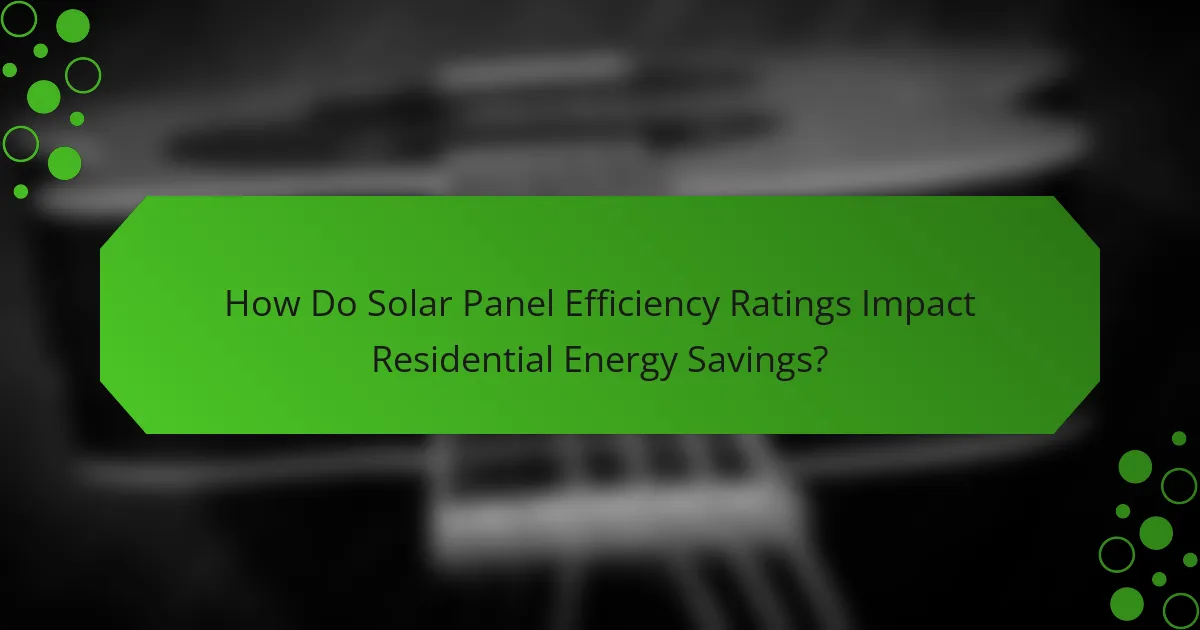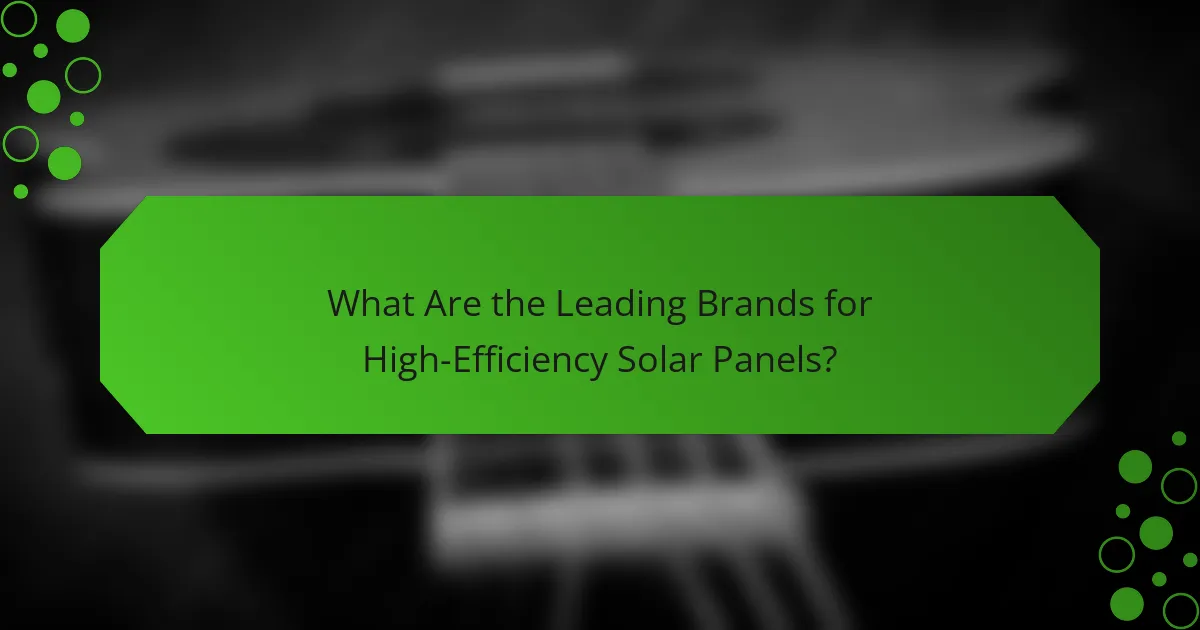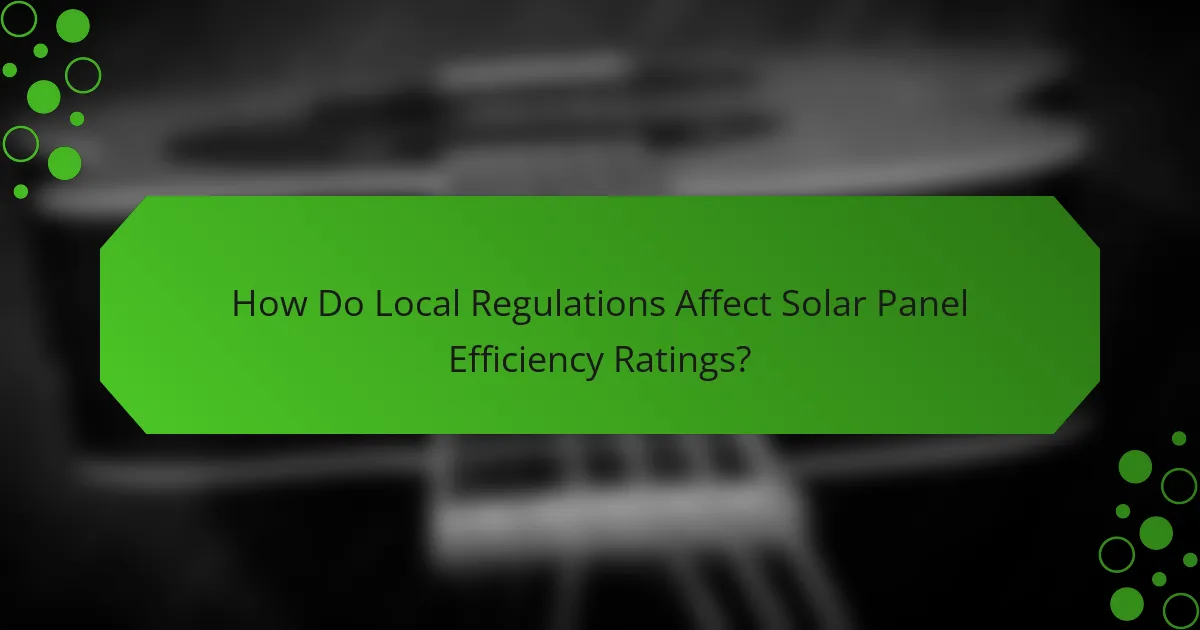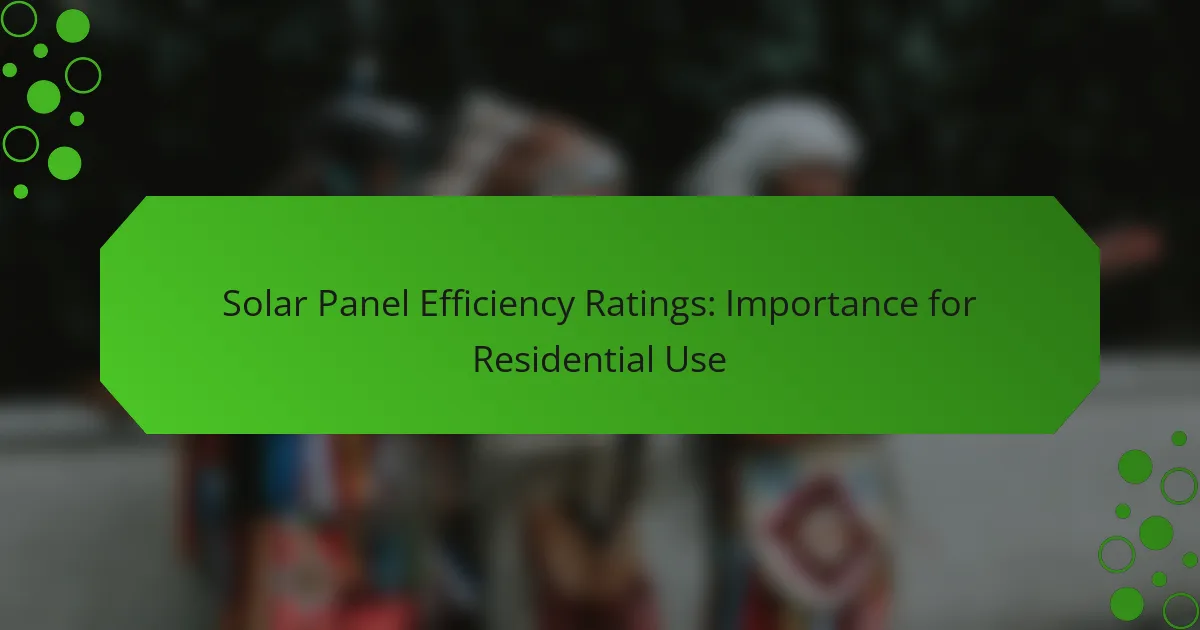Solar panel efficiency ratings play a crucial role in determining how effectively sunlight is converted into usable electricity for residential use. Higher efficiency ratings allow homeowners to maximize energy output and reduce electricity costs, making it essential to understand these ratings when selecting solar panels. By considering the efficiency of different panel types, homeowners can make informed decisions that align with their energy needs and financial goals.

How Do Solar Panel Efficiency Ratings Impact Residential Energy Savings?
Solar panel efficiency ratings significantly influence residential energy savings by determining how much sunlight can be converted into usable electricity. Higher efficiency ratings mean more energy output from the same amount of sunlight, leading to greater savings on electricity costs.
Increased energy output
Higher efficiency solar panels convert a larger percentage of sunlight into electricity, which directly increases energy output. For instance, panels with efficiency ratings above 20% can produce significantly more energy compared to those rated below 15%. This means homeowners can generate more power from their roofs, reducing reliance on grid electricity.
When selecting solar panels, consider the efficiency rating alongside your available roof space. If space is limited, opting for higher efficiency panels can maximize energy production without requiring additional square footage.
Lower electricity bills
As solar panel efficiency ratings improve, homeowners can expect lower electricity bills. More efficient panels generate more energy, which can offset a larger portion of monthly electricity costs. For example, a household using 800 kWh per month may see their bill significantly reduced with high-efficiency panels compared to standard options.
Additionally, many regions offer incentives for solar installations, which can further decrease upfront costs and enhance savings over time. It’s advisable to calculate potential savings based on local electricity rates and available incentives to understand the financial benefits fully.
Faster return on investment
Investing in higher efficiency solar panels often leads to a faster return on investment (ROI). While these panels may have a higher initial cost, the increased energy output and lower electricity bills can recoup that investment more quickly. Homeowners might see a payback period of 5-10 years, depending on local energy prices and incentives.
To maximize ROI, evaluate the total cost of installation, including any available tax credits or rebates. Comparing the long-term savings from different efficiency ratings can help determine the best financial decision for your solar investment.

What Are the Different Solar Panel Efficiency Ratings Available?
Solar panel efficiency ratings indicate how effectively a solar panel converts sunlight into usable electricity. These ratings vary by panel type and are crucial for homeowners to understand when selecting the best option for residential use.
Monocrystalline efficiency ratings
Monocrystalline solar panels typically have the highest efficiency ratings, often ranging from 15% to over 22%. This type of panel is made from a single crystal structure, allowing for better electron movement and higher energy conversion.
When choosing monocrystalline panels, consider their space efficiency. They generate more power per square meter, making them ideal for homes with limited roof space. However, they tend to be more expensive than other types, so weigh the upfront costs against long-term savings.
Polycrystalline efficiency ratings
Polycrystalline solar panels generally have efficiency ratings between 13% and 16%. These panels are made from multiple crystal structures, which can reduce their efficiency compared to monocrystalline options.
While polycrystalline panels are often less expensive, they require more space to produce the same amount of electricity as their monocrystalline counterparts. They are a good choice for homeowners with larger roofs or those looking for a more budget-friendly option.
Thin-film efficiency ratings
Thin-film solar panels have lower efficiency ratings, typically between 10% and 12%. They are made by layering photovoltaic materials on a substrate, which allows for flexibility and lightweight designs.
Although thin-film panels are less efficient, they can perform better in low-light conditions and high temperatures. They are suitable for larger installations where space is not a constraint and can be more affordable upfront, but homeowners should consider their overall energy needs when selecting this type.

Which Factors Influence Solar Panel Efficiency Ratings?
Solar panel efficiency ratings are influenced by several key factors that determine how effectively a panel converts sunlight into electricity. Understanding these factors can help homeowners select the best solar panels for their residential needs.
Temperature coefficient
The temperature coefficient indicates how much a solar panel’s efficiency decreases as temperatures rise. Most panels have a temperature coefficient ranging from -0.2% to -0.5% per degree Celsius above 25°C. This means that in hotter climates, efficiency can drop significantly, so it’s crucial to consider this factor when selecting panels for warmer regions.
For example, a panel with a -0.4% temperature coefficient will lose about 4% efficiency at 35°C compared to its rated performance at 25°C. Homeowners in hotter areas should look for panels with lower temperature coefficients to maximize energy production.
Panel design and materials
The design and materials of solar panels play a significant role in their overall efficiency. Monocrystalline panels are generally more efficient than polycrystalline panels, with efficiencies often exceeding 20% compared to 15-17% for polycrystalline. The choice of materials affects not only efficiency but also durability and longevity.
Additionally, advanced technologies like bifacial designs can capture sunlight from both sides, potentially increasing energy output. When choosing panels, consider both the efficiency rating and the technology used to ensure optimal performance for your home.
Installation quality
The quality of solar panel installation can greatly impact efficiency ratings. Proper alignment, angle, and orientation towards the sun are essential for maximizing energy capture. A well-installed system can enhance performance by 10-20% compared to a poorly installed one.
Homeowners should hire experienced professionals who follow industry best practices and local regulations. Regular maintenance checks can also help identify and resolve any installation-related issues, ensuring that the system operates at peak efficiency over its lifespan.

How to Choose the Right Solar Panels Based on Efficiency Ratings?
Choosing the right solar panels involves understanding efficiency ratings, which indicate how effectively a panel converts sunlight into electricity. Higher efficiency ratings generally mean more energy production in less space, making them crucial for residential use.
Assessing energy needs
Start by evaluating your household’s energy consumption. Look at your electricity bills to determine your average monthly usage in kilowatt-hours (kWh). This figure will help you estimate the size of the solar panel system you need to meet your energy demands.
Consider factors such as the number of occupants, appliances, and seasonal variations in energy use. For instance, a family with multiple electronic devices may require a larger system compared to a household with minimal energy needs.
Comparing efficiency ratings
Efficiency ratings for solar panels typically range from around 15% to over 22%. Higher-rated panels convert a greater percentage of sunlight into usable energy, which is particularly beneficial if roof space is limited. Look for panels that meet or exceed the average efficiency rating for your region.
When comparing options, also consider the technology used, such as monocrystalline or polycrystalline panels. Monocrystalline panels often offer higher efficiency but may come at a premium price compared to their polycrystalline counterparts.
Evaluating warranty and lifespan
Solar panels usually come with warranties ranging from 10 to 25 years, covering performance and manufacturing defects. A longer warranty often indicates better quality and reliability, which can be crucial for long-term investment.
Additionally, consider the expected lifespan of the panels. Most high-quality solar panels can last 25 years or more, maintaining a significant portion of their efficiency throughout that time. Ensure you understand the terms of the warranty and what is covered to avoid unexpected costs later on.

What Are the Leading Brands for High-Efficiency Solar Panels?
The leading brands for high-efficiency solar panels include SunPower, LG Solar, and Panasonic. These companies are recognized for their advanced technology and reliable performance, making them top choices for residential solar installations.
SunPower
SunPower is renowned for producing some of the highest efficiency solar panels on the market, often exceeding 22% efficiency. Their Maxeon technology features a unique cell design that reduces energy loss and enhances durability.
When considering SunPower panels, homeowners should evaluate their long-term warranties, which typically last 25 years, ensuring peace of mind regarding performance and reliability. The initial investment may be higher, but the efficiency can lead to significant savings on energy bills over time.
LG Solar
LG Solar offers a range of high-efficiency panels, with their NeON series achieving efficiencies around 21%. These panels are designed with advanced technology that minimizes shading effects and maximizes energy output.
Homeowners should consider LG’s strong warranty program, which also spans 25 years, providing assurance of product longevity. While the upfront cost is competitive, the long-term performance and efficiency can yield excellent returns on investment.
Panasonic
Panasonic is known for its HIT (Heterojunction with Intrinsic Thin layer) technology, which allows their panels to reach efficiencies of about 19-21%. This technology enhances performance in high temperatures, making them suitable for various climates.
When choosing Panasonic panels, buyers should note the 25-year warranty that covers both product and performance. The combination of efficiency and reliability makes Panasonic a solid option for homeowners looking to invest in solar energy.

How Do Local Regulations Affect Solar Panel Efficiency Ratings?
Local regulations can significantly influence solar panel efficiency ratings by establishing standards for installation, performance, and safety. These regulations ensure that solar systems meet specific criteria, which can affect their overall efficiency and effectiveness in residential applications.
Building codes
Building codes dictate the structural requirements for solar panel installations, including mounting systems and electrical connections. Compliance with these codes is essential to ensure safety and optimal performance of the solar system.
For example, some regions may require specific types of mounting hardware to withstand local weather conditions, which can impact the efficiency of the solar panels. Homeowners should consult local building codes to understand the necessary specifications and avoid costly modifications later.
Additionally, understanding these codes can help homeowners select the right contractors who are familiar with local regulations, ensuring a smoother installation process and adherence to efficiency standards.
